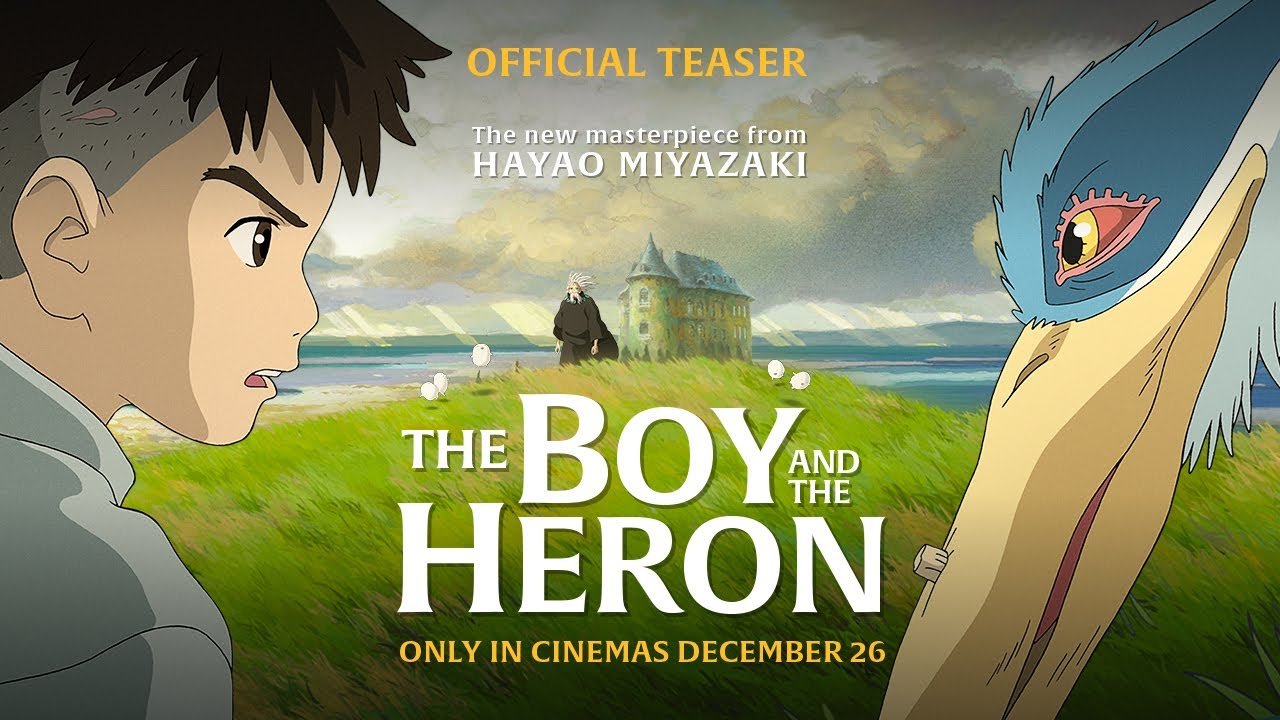The Boy and the Heron: Film Review
A beautiful fantasy suffering from success.
Pictured: Promotional Poster, IMDB.
★★★☆☆
This summer, the award-winning Studio Ghibli has released yet another film to a iconic chain of hits by their acclaimed director Hayao Miyazaki.
The Boy and the Heron casts Soma Santoki as young boy protagonist Mahito Maki. The film is a semi-autobiographical version of Miyazaki’s childhood. The film depicts a coming of age in the cruel unrelenting world of Japan during World War Two.
While the film presents amazing cinematography and artistic style, a token of Miyazaki, it unfortunately falls long short in plot. Many elements showcase strong potential; however time constraints create glaring oversimplification and plot-holes for the viewer.
It begins with Mahito, a victim of the Tokyo Bombings of 1942, a blaze of fires spread across the city. He witnesses his mother, Himi, a wartime nurse, die to heat. Three years pass, and his father, Shoichi, marries his aunt Natsuki (Yoshina Kimuara). Mahito’s strained relationship with her and bullying in school leaves him disconnected. A grey heron (Robert Pattinson) stalks his location.
Watching this film, you really see the beautiful creative direction by Miyazaki. Many scenes of the countryside remind me of peaceful memories of picnics in parks and more. It is this cosiness that redeems the film’s shortfalls that soon become apparent.
His mother’s death impacts Mahito. Natsuki, carrying Mahito’s father’s baby, escapes into the forest. Panic erupts by the house servants, and Mahito rushes to a hidden tower within the fauna beckoned by the Grey Heron. Locked inside the tower, the Heron’s trap, he is sentenced to the underworld by a mysterious old man. This world is archipelago, depicting herons and parakeets, but also the souls of the dead.
Natsuki’s disappearance is never explained. Her strained relationship with Mahito is assumed, however despite Mahito’s later pleads for her to return, she does not acquiesce. Separately, why the Grey Heron attempted to kill Mahito, or at least injure him is also never explained, given their later alliance by necessity.
Mahito meets Kiriko (Kô Shibasaki), a fisherman. She resembles his above world servant but has no recollection of being there. Boarding her ship, they sail to catch fish for the dead souls, and Warawara, cute white blobs that symbolise new life. In the evening the Warawara raise to the sky to join the above world, however their journey is stopped by the hungry wild Heron with nothing to eat that roam the world. Mahito sympathises with their injustice and joins the Grey Heron to challenge the world god.
Their journey leaves them stranded with the Parakeet civilisation. Humanoid parakeets are revealed to protect the Great Uncle (Mark Hamill), who controls the world. The parakeets attempt to eat Mahito, however he is saved by child version of Himi who casts fire to protect them. Himi explains she guided Natsuki away from the chaos of the living world. Mahito breaks taboo and enters Natsuki’s birthing room. His pleads fail, and he is captured by guards.
Now the plot explains that Himi as a young girl had briefly disappeared after going missing in the forest. Once she returned, she forgot all events of the tower. But, according to film events, Himi was able to guide Natsuki outside of the world and was knowledgeable of many events that soon occurred.
Hayao Miyazaki, Pictured.
This glaring hypocrisy unfortunately demonstrated the time constraints of the film, as it felt a crucial plot point was missed to why this was the case. It also alludes to a potential time loop that affects the world which also if true, completely overrides the rest of the plot.
Appearing in his dreams, Great Uncle reveals Mahito was brought to be his successor. With his visible age shown, he unveils the world is controlled by building blocks that must be arranged every three days. The dream is abruptly cut short when Mahito awakes in a Parakeet dungeon. He escapes with Grey Heron to the top of the tower, where the Great Uncle resides. Separately, Himi visits Great Uncle with the Parakeet King. The king announces his dissatisfaction with the succession, showing his want to reign supreme.
Entering the Rooftop Garden, unknowingly being stalked by the king, Great Uncle reveals the blocks. Mahito rejects the offer of being God. He rejects the injustice shown to the people. The king intervenes and launches a coup. His rush knocks the blocks and smashes them on the ground, causing the world to collapse.
Here lies the other issue the film presents. Great Uncle appears to show genuine care for the world. Yet the injustice of his controlling actions is never explained. The ending at this point feels underwhelming, and an eluded fight between the Parakeet King and Mahito does not take place.
Mahito, voiced by Soma Santoki, Pictured.
Additionally, the film has no consistent antagonist which confuses who the audience should sympathise with.
Himi convinces Natsuki to leave. The group flee to the exit doors and exchange final goodbyes. Himi reveals how proud of Mahito she is. As the world collapses, Mahito and Grey Heron escape into the real world. Strangely Mahito remembers the significant events that occurred, and it is revealed he kept one of the building blocks.
The ending is very consistent with the film. Explanations are either not given or assumed. Characters showcase development demonstrated outside of scenes.
As a viewer, the ability to be able to follow and understand a plot matters. The Boy and the Heron showcases incredible plot potential, art, and cinematography. Personally, I found the film reminiscent of Alice in Wonderland, and the idea of a sequel would have fitted the film plot nicely.
The film is not unwatchable. The scenery, and story assumptions make up the glaring issues. However, for what is considered by some to be Miyazaki’s last film, it is certainly not a great place to finish.
Zane LeBlond, Cultural Trends Reporter.



